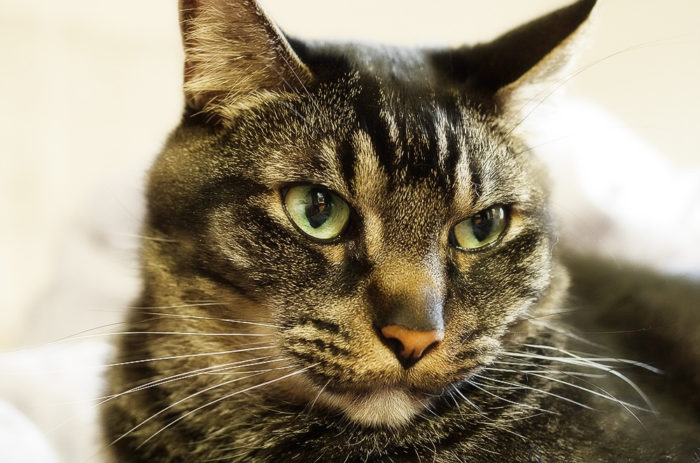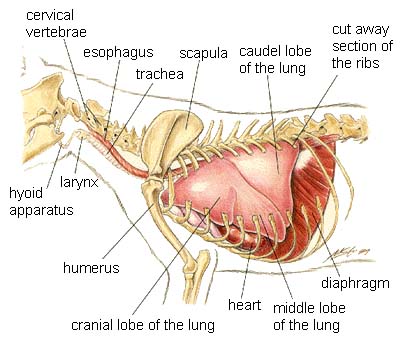Weak or frequent breathing in the cat signals changes in the body of the pet. Deviation from the norm is not always a pathology. But the owner must be able to recognize a dangerous symptom in order to provide the pet in time for help. How do cats breathe and what are some of the changes in breathing?
The respiratory system of a cat is similar to the human. First, air enters the larynx through the pharynx, then moves along the trachea to the bronchi and into the lungs. From the lungs, oxygen is delivered to every cell of the body. On exhalation, at the moment of diaphragm relaxation, the “spent” material is removed from the body by the reverse way: through the bronchi to the trachea, larynx and pharynx. The frequency of respiration in cats is a non-permanent indicator. In a calm state, the adult animal makes about thirty breaths / minutes. In kittens this indicator is higher and can reach up to fifty. Cats breathe a little more often cats, but the difference is insignificant.
Situations when frequent breathing in a cat is not a pathology, a lot. For example, from a fright, anger, surprise or at the moment of joyful excitation the cat breathes more often. This is a momentary change, breathing returns to normal in a short time, usually after the cessation of the effect of external stimuli on the cat. The shallow, rapid breathing of a cat during a trip, in a vet’s office or during an unpleasant manipulation is a conditional norm signaling that the pet is experiencing stress. Pregnant, giving birth, feeding nurses and cats during the estrus, too, breathe a little faster. The frequency of respiration in cats varies depending on the degree of exercise: in the dream the indicator is lower, during active games – higher.
Changing breathing is an alarming sign
The change in the depth and frequency of breathing can be a sign of the deteriorating health of the pet. These indicators change with an increase in body temperature, during pain, dehydration, hypothermia, or overheating. In the latter case, frequent breathing in the cat through the mouth is observed, and when undercooling the cat, on the contrary, breathes barely noticeably – the stomach and ribs almost do not change the position when inhaling / exhaling.
The predominant abdominal breathing in cats, when the ribs barely move on inhaling / exhaling, and the stomach, on the contrary, visibly rises and falls, may be a sign of congenital pathology, a chronic disease of internal organs and systems. The cat breathes “belly” if its ribs, chest muscles, spine, lungs are damaged – in any situation when the usual breath inflicts pain.
Infections, viruses and diseases of internal organs are accompanied by other symptoms, and a change in breathing in this case is only an indirect sign. However, the owner must necessarily inform the veterinarian of any violations, so that the doctor quickly diagnosed. For example, heavy breathing in a cat with an increase in body temperature and a dry cough can be a symptom of bronchitis. If the pet suffers from an allergy, the difficulty in breathing in a cat during an exacerbation of the disease can be a sign of a laryngeal edema.
If in general the condition of the pet is satisfactory, but the cat is clearly difficult to breathe, you should carefully examine the oral cavity and larynx. Perhaps a foreign object was stuck in the throat, which should be removed as soon as possible. The hoarseness in the chest indicates the accumulation of fluid or mucus, which prevents the normal circulation of air. If the cat wheezes while breathing through the nose, on exhalation and inspiration, whistling sounds or sniffs are heard, it is possible that a foreign object or mucous membrane has become inflamed to the nasopharynx so that the air can not freely penetrate through the nose. A wheezing breath is an alarming sign that appears in many cases: swelling, pneumonia, heart disease.
Frequent superficial and heavy breathing in a cat can be a sign of trauma, imperceptible at first sight. The pet should be carefully examined, looking for traces of a stroke: bruises, bruises, wounds, painful touch of the body, torn wool. Usually the behavior of a cat is easy to understand that she is experiencing pain: constrained movements, apathy, poor appetite, thirst.
Any changes in breathing should be consulted with a doctor. Immediately deliver the cat to the clinic if:
- there are any other disturbing symptoms of the ailment;
- the pulse is rapid or weak;
- the mucous membranes turned pale, blushed, or turned blue;
- in the chest something rattles, gurgles, snorts, whistles;
- a liquid is released from the mouth or nose.
If the pet does not breathe (the gums turn pale or turn blue, if the gums are red – oxygen enters the body), it is necessary to make artificial respiration to the cat. Manipulation is carried out until the respiratory function is restored or all the way to the clinic.
It is not difficult to do this:
- fix the cat so that its neck is straightened and makes a single line with the spine;
- the mouth of the pet should be closed, the mouth freed from saliva, foam, mucus;
- take a deep breath, breathe out the air into the cat’s nose through the palm, folded with a tube. You can cover the mouth of a cat with a thin handkerchief and clasp your nose with your lips, without using your hand;
- frequency about twenty times per minute, the depth depends on the size of the pet. Kittens do artificial respiration should be especially careful, because with too much exhalation, you can damage small lungs (they simply can not accommodate the expired volume of air). To calculate the volume, put a palm on the chest of the cat: easy enough expansion, do not overdo it;
- pulse check every 15-20 seconds. If the heart stops beating – do not panic! Usually (if the cat can still be saved), the heart rhythm is restored within 10-15 minutes of indirect massage;
- we grasp the palm of the cat’s sternum from below so that it is sandwiched between the thumb on one side and the other fingers on the other. Sharply compress and relax your fingers (five times in a row), then inhale air once into the nose of the cat, then again five compressions of the thorax. Every two minutes, we check to see if the heart beat. Excellent, if there is an assistant: one person does artificial respiration, and the second continuously conducts heart massage.



















